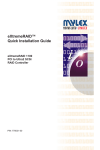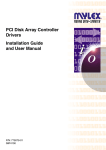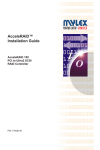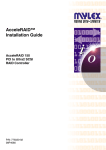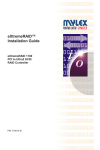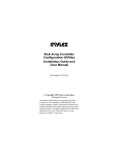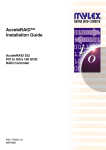Download Mylex AcceleRAID 200 Installation guide
Transcript
AcceleRAID™ Quick Installation Guide AcceleRAID 150 AcceleRAID 200 AcceleRAID 250 PCI to Ultra2 SCSI RAID Controllers P/N: 775030-00 AcceleRAID™ Quick Installation Guide AcceleRAID 150 AcceleRAID 200 AcceleRAID 250 PCI to Ultra2 SCSI RAID Controllers Part Number 775030-00 © Copyright 1999 Mylex Corporation. All Rights Reserved. All contents of this manual are copyrighted by Mylex Corporation. The information contained herein is the exclusive property of Mylex Corporation and shall not be copied, transferred, photocopied, translated on paper, film, electronic media, or computer-readable form; or otherwise reproduced in any way, without the express written permission of Mylex Corporation. Greetings Thank you for purchasing the Mylex AcceleRAID™ 150/200/250 controller. This manual describes the installation of the Mylex AcceleRAID controllers. Requests for technical information about this and other Mylex Corporation products should be made to your Mylex authorized reseller or Mylex sales representative. Please Notice Mylex is a registered trademark, and AcceleRAID, DAC960PRL, and DAC960PTL are a trademarks of Mylex Corporation. Microsoft, MS-DOS and Windows are registered trademarks of the Microsoft Corporation. Novell is a registered trademark of Novell corporation. LSI and Symbios Logic are registered trademarks of LSI Logic Corporation. Other names that are trademarks may be used herein for the purpose of identifying the products or services of their respective owners. Unless otherwise noted, companies, names and data used in examples herein are fictitious. Our Policy Although reasonable efforts have been made to assure the accuracy of the information contained herein, this publication could include technical inaccuracies or typographical errors. Mylex Corporation expressly disclaims liability for any error in this information, and for damages, whether direct, indirect, special, exemplary, consequential or otherwise, that may result from such error, including but not limited to loss of profits resulting from the use or misuse of the manual or information contained therein (even if Mylex Corporation has been advised of the possibility of such damages). Any questions or comments regarding this document or its contents should be addressed to Mylex Corporation at the address shown on the cover. The following paragraph does not apply to the United Kingdom or any country where such provisions are inconsistent with local law: MYLEX CORPORATION PROVIDES THIS PUBLICATION “AS IS” WITHOUT WARRANTY OF ANY KIND, EITHER EXPRESS OR IMPLIED, INCLUDING, BUT NOT LIMITED TO, THE IMPLIED WARRANTIES OF MERCHANTABILITY OR FITNESS FOR A PARTICULAR PURPOSE. Some states do not allow disclaimer of express or implied warranties or the limitation or exclusion of liability for indirect, special, exemplary, incidental or consequential damages in certain transactions; therefore, this statement may not apply to you. Also, you may have other rights which vary from jurisdiction to jurisdiction. Information in this publication is subject to change without notice and does not represent a commitment on the part of Mylex Corporation. Changes may be made periodically to the information herein; these changes will be incorporated in new editions of the publication. Mylex Corporation reserves the right to make improvements and/or changes at any time in the product(s) and/or program(s) described in this publication. It is possible that this publication may contain reference to, or information about, Mylex Corporation products (machines and programs), programming or services that are not announced in your country. Such references or information must not be construed to mean that Mylex Corporation intends to announce, provide, or make available such Mylex products, programming, or services in your jurisdiction. Regulatory Information The AcceleRAID 150, 200, and 250 comply with the following regulatory agencies: Federal Communications Commission The FCC information statements are in Appendix C of the AcceleRAID 150 Installation Guide (P/N 775024) and Appendix C of the AcceleRAID 200 and 250 Installation Guide (P/N 775007). Community of Europe The CE information statements are in Appendix C of the AcceleRAID 150 Installation Guide (P/N 775024) and Appendix C of the AcceleRAID 200 and 250 Installation Guide (P/N 775007). Underwriters Laboratories , WARNING This controller is furnished with a nonvolatile RAM (NVRAM) chip that uses a sealed lithium battery/crystal module. Replace the module only with the same or equivalent type recommended by the manufacturer. Dispose of the used battery/ crystal module according to the manufacturer's instructions. Never incinerate a battery as it could explode and cause serious injury. Table of Contents Hardware Introduction – Assumptions .................................................................. 1 Types of Installations ............................................................................ 1 Standard Installation ...................................................................... 1 SCSI Interrupt Steering Logic (SISL) Installation .......................... 1 Performing a Standard Installation ....................................................... 2 Performing a SCSI Interrupt Steering Logic (SISL) Installation ............ 6 RAID Configuration Using RAID EzAssist .......................................................................... 11 Operating Systems and Drivers NetWare ............................................................................................. 14 Installing the Mylex Disk Array Controller as the Primary NetWare 4.11/4.2 Controller .......................................... 14 Installing the Mylex Disk Array Controller into an Existing NetWare 4.11/4.2 System .............................................. 15 Overview of NetWare 5.0 .................................................................... 17 Mylex Disk Array Controller Driver Files for NetWare ................. 17 Tape and CD-ROM Support ........................................................ 17 Mylex Disk Array Controller Driver for NetWare 5.0 ....................................................................................... 18 Installing the Mylex Disk Array Controller as the Primary NetWare 5.0 Controller .................................................. 18 Installing the Mylex Disk Array Controller into an Existing NetWare 5.0 System ...................................................... 21 Windows NT ....................................................................................... 23 Installing the Mylex Disk Array Controller as the Primary Windows NT 4.x Controller ............................................ 23 Installing the Mylex Disk Array Controller into an Existing Windows NT 4.x System ................................................ 25 Manual No. 775030 iv Hardware Introduction – Assumptions The AcceleRAID 150, AcceleRAID 200 and the AcceleRAID 250 are very versatile Ultra2 SCSI, LVD RAID controllers. There are literally thousands of possible hardware configurations. In order to keep this Quick Installation Guide down to a manageable size, the following assumptions are being made: • A RAID 0, 1, or 5 installation is being installed. • The user is familiar with Windows NT® or Novell® NetWare® . • The user is familiar with disk drive and RAID terminology. Types of Installations There are two types of installations: • Standard Installation • SCSI Interrupt Steering Logic (SISL) Installation Standard Installation In a standard installation, the AcceleRAID 150 or the AcceleRAID 250 functions as a single-channel, standard PCI to Ultra2 SCSI, LVD RAID controller. In a standard installation, the AcceleRAID 150 or 250 can be installed into any system board with an available PCI (2.1 compliant) slot. SCSI Interrupt Steering Logic (SISL) Installation In a SISL installation, the AcceleRAID 200 adds RAID functionality to a system board that has one or more embedded SCSI channels. The AcceleRAID 150 or 250 adds an Ultra2 SCSI, LVD RAID channel as well as RAID functionality to a system board that has one or more embedded SCSI channels. For a SISL implementation, the AcceleRAID controllers must be plugged into a special, pre-wired PCI slot in a system board that is specially designed for this type of installation. Check with the manufacturer of your system board to find out if it has embedded SCSI channels that can be controlled by a PCI to SCSI RAID controller with SCSI Interrupt Steering Logic (a requirement for the AcceleRAID 200). Manual No. 775030 1 Performing a Standard Installation Performing a Standard Installation (AcceleRAID 150 and AcceleRAID 250 only) m Caution If an operating system or existing data resides on SCSI disk drives already installed on the system, a full backup should be performed on these drives prior to this installation. 1. Be sure power is turned off and the system is not plugged into an electrical outlet. , WARNING To avoid electrical shock, do not attempt to perform this hardware installation with power on. Disconnect the system from the electrical wall outlet. 2. If JP10 on the AcceleRAID 150 or 250 is installed, remove it, as shown in Figure 1 and in Figure 2. J1 Internal Connector (68-Pin High Density) J2 External Connector (VHDCI) 1 Jumper on 3 JP1 SE U1 JP4 LVD JP5 2 Jumper off Jumper removed and placed over a single pin for safekeeping JP10 Note: J1 and J2 are both on the same Channel. Figure 1. AcceleRAID 150 with Component Locations Table 1. AcceleRAID 150 Jumpers and LEDs Jumpers Description JP1 Header for SCSI activity LED (Pin 1 – active low, Pin 2 – Vcc) JP4 Mylex use only JP5 Not used JP10 Off for standard – On for SISL 2 LEDs Description U1 On – controller failed startup diags. LVD SE LVD mode on unless SE device detected. Single-ended device detected AcceleRAID 150/200/250 Quick Installation Guide Hardware J1 Internal Connector (68-Pin High Density) JP4 JP1 JP5 J2 External Connector (VHDCI) 1 Jumper on 3 2 Jumper off Jumper removed and placed over a single pin for safekeeping JP10 Note: J1 and J2 are both on the same Channel. Figure 2. AcceleRAID 250 with Component Locations Table 2. AcceleRAID 250 Jumpers Jumpers JP1 JP4 JP5 JP10 Description Header for SCSI activity & Cache Dirty LEDs Mylex use only Not used Off for standard – On for SISL VCC JP1, LED Connector Channel Activity LED* Cache Dirty LED* * Active low Figure 3. Pinout for JP1 on the AcceleRAID 250 3. Plug the AcceleRAID 150 or 250 card into an available PCI slot (see Figure 4). Manual No. 775030 3 Performing a Standard Installation System Board Plug Controller into any Available PCI Slot Figure 4. .Plugging the AcceleRAID 150 or 250 into a Standard PCI Slot 4. Set the SCSI ID on each internal drive to a unique address between 0 and 15, but do not use address 7, as it is reserved for the controller. See the documentation that comes with your drives for instructions on how to do this. m Caution If internal and external drives are used, be sure that no drive addresses are duplicated. External SCSI cabinets usually automatically assign drive addresses according to where in the cabinet the drives are located. 5. Be sure termination is disabled on all drives connected to the controller. See the documentation that comes with your drives for instructions on how to do this. 6. Be sure that termination power is enabled on all drives connected to the controller. See the documentation that comes with your drives for instructions on how to do this. 7. Connect a wide, high-density, 68-pin SCSI ribbon cable to the internal SCSI connector on the AcceleRAID 150 or 250 and connect the other cable connectors to any internal SCSI drives as required. See Figure 5. 8. Connect an active terminator to the end of the SCSI ribbon cable at the end farthest from the controller. See Figure 5. 4 AcceleRAID 150/200/250 Quick Installation Guide Hardware T T Figure 5. Connecting Internal and External Drives 9. Connect a wide, round, 68-pin Very High Density Connector Interface (VHDCI) cable to the external SCSI connector on the AcceleRAID 150 or 250 and connect the other end of the cable to an external drive cabinet as required. See Figure 5. External drive cabinets usually have termination built into the end of the SCSI bus. Check the documentation that comes with your drive cabinet to be sure this is the case. If not, use an active terminator at the end of the bus. ☛ Note An AcceleRAID 150 or 250 automatically determines whether or not its own on-board termination is required, and automatically enables or disables onboard termination as necessary. System Board Plug Controller into any Available PCI Slot Figure 6. AcceleRAID 150 or 250 in a Typical Standard Installation The hardware portion of the standard installation is complete. Continue on to “RAID Configuration” on page 11. Manual No. 775030 5 Performing a SCSI Interrupt Steering Logic (SISL) Installation Performing a SCSI Interrupt Steering Logic (SISL) Installation m Caution If an operating system or existing data resides on drives connected to the system board’s resident SCSI channels, a full backup must be performed on these drives prior to this installation, as these drives will no longer be readable after this installation is performed. 1. Be sure power is turned off and the system is not plugged into an electrical outlet. , WARNING To avoid electrical shock, do not attempt to perform this hardware installation with power on. Disconnect the system from the electrical wall outlet. 2. If JP10 on the AcceleRAID 150 or 250 is not installed, install it, as shown in Figure 1 and Figure 2. On the AcceleRAID 200 JP10 is permanently installed, as shown in Figure 7. JP4 JP1 JP5 JP10 Figure 7. AcceleRAID 200 with Component Locations 6 AcceleRAID 150/200/250 Quick Installation Guide Hardware Table 3. AcceleRAID 200 Jumpers Jumpers JP1 JP4 JP5 JP10 Description Header for SCSI activity & Cache Dirty LEDs Mylex use only Not used On for SISL – Off for standard VCC JP1, LED Connector Channel Activity LED* Cache Dirty LED* * Active low Figure 8. Pinout for JP1 on the AcceleRAID 200 m Caution Before you Continue: If the SCSI channels embedded on the system board are controlled by a Symbios Logic® chipset, the Symbios chips must be disabled in the system BIOS before proceeding with RAID configuration, operating system installation or driver installation. This is to allow the AcceleRAID to take over control of the system board's embedded channels without any conflicts. The Symbios chipset can be disabled by running the CMOS setup routine when powering on your system (see the documentation that is furnished with your system). 3. Plug the AcceleRAID card into the specially prewired SISL PCI slot. See the documentation provided with your system board to locate this special PCI slot (see Figure 9). ☛ Note When an AcceleRAID 150 or 250 is plugged into the SISL PCI slot, the channel on the controller automatically assumes the address of Channel 0. The addresses of the channels on the system board are pushed out by one. Manual No. 775030 7 Performing a SCSI Interrupt Steering Logic (SISL) Installation System Board Plug Controller into the Specially Wired SISL PCI Slot Wide SCSI Connector on System Board Narrow SCSI Connector on System Board Figure 9. Plugging the AcceleRAID into a Prewired SISL PCI Slot 4. For each channel, set the SCSI ID on each internal drive to a unique address between 0 and 15, but do not use address 7, as it is reserved for the controller. See the documentation that comes with your drives for instructions on how to do this. m Caution If internal and external drives are used, be sure that no drive addresses on a given channel are duplicated. External SCSI cabinets usually automatically assign drive addresses according to where in the cabinet the drives are located. 5. Be sure termination is disabled on all disk drives connected to the controller or connected to the system board. See the documentation that comes with your drives for instructions on how to do this. 6. Be sure that termination power is enabled on all disk drives connected to the controller or connected to the system board. See the documentation that comes with your drives for instructions on how to do this. 7. Connect a wide, 68-pin, high-density SCSI ribbon cable to the internal SCSI connector on the AcceleRAID 150 or 250 and connect the other cable connectors to any internal SCSI drives as required. See Figure 10. 8 AcceleRAID 150/200/250 Quick Installation Guide Hardware T T Figure 10. Connecting Internal and External Drives 8. Connect an active terminator to the end of the SCSI ribbon cable at the end farthest from the controller. See Figure 10. 9. Connect a wide, round, 68-pin VHDCI cable to the external SCSI connector on the AcceleRAID 250 and connect the other end of the cable to an external drive cabinet as required. See Figure 10. External drive cabinets usually have termination built into the end of the SCSI bus. 10. Connect a wide, 68-pin, high-density SCSI ribbon cable to the SCSI connector on the system board and connect the other cable connectors to any internal SCSI drives as required. ☛ Note If a narrow SCSI connector is available on the system board, this should be used for non-disk SCSI peripherals, such as tape or CDROM drives which will not be a part of a RAID array. Manual No. 775030 9 Performing a SCSI Interrupt Steering Logic (SISL) Installation System Board T Channel 0 T Plug Controller into the Specially Wired SISL PCI Slot Wide SCSI Connector on System Board (Ch 1) Narrow SCSI Connector on System Board (Ch 2) Figure 11. AcceleRAID 150 or 250 in a Typical SISL Installation System Board Plug Controller into the Specially Wired SISL PCI Slot T Wide SCSI Connector on System Board (Ch 1) Narrow SCSI Connector on System Board (Ch 2) Figure 12. AcceleRAID 200 in a Typical SISL Installation The hardware portion of the SISL installation is complete. Continue on to “RAID Configuration” on page 11. 10 AcceleRAID 150/200/250 Quick Installation Guide RAID Configuration Using RAID EzAssist RAID EzAssist, the on-board BIOS Configuration Utility is used to build several types of RAID configurations. Since this is a Quick Installation Guide, only the Automatic Configuration option will be described here. ☛ Note A first time installation is being assumed. The following limitations apply to Automatic Configuration: • Only one array will be configured using the Automatic Configuration option. • All drives being controlled by the AcceleRAID board can be different sizes, but will all be formatted to the size of the smallest disk controlled by the AcceleRAID board. • A maximum of 7 drives can be configured into an array using Automatic Configuration. Any additional drives will become hot spares. The drives with the largest capacity (if mixed drive sizes are used) will be the drives selected to become hot spares. ☛ Note If you want to do anything other than an automatic configuration, refer to the RAID EzAssist Configuration Utility User Reference Guide. To perform a RAID configuration with the Automatic Configuration option using RAID EzAssist, do the following: 1. First power on any disk enclosures connected to the AcceleRAID controller, and then power on the computer. The AcceleRAID controller is furnished with the BIOS enabled by default. 2. Watch the messages on the screen for the following prompt to be displayed: Press <ALT-M> for BIOS options Wait approximately 5 seconds. Do not press any keys at this time. Manual No. 775030 11 Using RAID EzAssist ☛ Note If the BIOS has been disabled on the controller, You will need to press Alt–M to enable it (See your controller’s Installation Guide for details). 3. Watch the messages on the screen for the following prompt to be displayed: Press <ALT-R> for RAID Configuration options 4. Press Alt–R to get into RAID EzAssist (the configuration utility). ☛ Note For more detailed information on how to run the RAID EzAssist, refer to the RAID EzAssist Configuration Utility User Reference Guide (P/N 775029), which is included on the distribution CDROM. The utility will scan all available drive channels for SCSI devices. Upon completion of the scan, the following will occur under the following conditions: a. More than one controller: Select Controller will appear on the screen. In this case use the arrow keys to select the controller you wish to configure and press Enter. This causes condition b b. Either one controller, or a controller was selected in a, and no RAID configuration exists: No existing RAID configuration has been detected. Would you like to configure a RAID drive now? [Yes] No Select Yes with the arrow keys and Press Enter. This takes you to step 5. 12 AcceleRAID 150/200/250 Quick Installation Guide RAID Configuration 5. The following options appear: Automatic Assisted Custom Select Automatic. Press Enter. ☛ Note The Scope of this Quick Reference Guide only covers Automatic Configuration. For information on performing Assisted or Custom RAID configurations, refer to the RAID EzAssist Configuration Utility User Reference Guide (P/N 775029). A summary display of the configuration will appear. Up to 5 lines will be displayed. If more than 5 SCSI drives are physically connected to the controller, press Page Down to see up to 5 more lines. 6. Select Apply. Press Enter. The Array will be automatically configured. The program will indicate that Automatic Configuration is in progress until the configuration finishes. Upon completion, the following prompt will be displayed: RAID drive configuration is successful. You may utilize this drive immediately. [Reboot] Main Menu 7. Select Main Menu and press Enter if you want to further examine the configuration. Or Select Reboot and press Enter to restart your system. Go on to “Operating Systems and Drivers” on page 14. Manual No. 775030 13 Operating Systems and Drivers NetWare Installing the Mylex Disk Array Controller as the Primary NetWare 4.11/4.2 Controller If the Mylex Disk Array Controller will be the primary (bootable) controller, you must install the controller driver at the time of NetWare 4.11/4.2 installation. The procedure below assumes that the CD-ROM drivers are available. 1. Boot the system from a newly created DOS boot drive, and then create (or edit) the CONFIG.SYS and AUTOEXEC.BAT files to include the drivers required for accessing the CD-ROM as a logical drive under DOS. The following example assigns the CD-ROM as drive D: under MS-DOS 6.00 or above. CONFIG.SYS contains the statements: device = [pathname]\aspidac.sys device = [pathname]\btcdrom.sys /D:[devicename] AUTOEXEC.BAT contains the statement: [pathname]\mscdex /v /m:10 /D:[devicename] The device name is that of the specific CD-ROM drive (e.g., MSCD001). 2. Boot the system with the new CONFIG.SYS and AUTOEXEC.BAT, and make sure the NetWare CD-ROM files are accessible under DOS. 3. Follow the standard NetWare 4.11/4.2 upgrade or installation procedure, as described in the NetWare 4.11/4.2 documentation. 4. Insert the NT/NW drivers diskette into the floppy disk drive when the installation program prompts you to insert the vendor-supplied disk. The installation program will scan the diskette for all available drivers. Select the NetWare 4.11/4.2 driver from the list. MDAC.HAM 14 AcceleRAID 150/200/250 Quick Installation Guide Operating Systems and Drivers 5. After the NetWare 4.11/4.2 installation is complete, copy the files in the \NW subdirectory of the NT/NW drivers diskette to SYS:SYSTEM of the NetWare 4.11/4.2 server. To install GAM server, refer to the Disk Array Controller Software Kit Installation Guide and User Manual (P/N 771929). To install the GAM client, refer to the Global Array Manager Client Software Installation Guide and User Manual (P/N 771961). Installing the Mylex Disk Array Controller into an Existing NetWare 4.11/4.2 System If NetWare 4.11/4.2 is already installed and you wish to add a Mylex Disk Array Controller later, the controller will be a secondary (non-bootable) controller. After installing the controller hardware and configuring a disk array, follow the procedure below to add the necessary controller drivers. 1. With NetWare Server 4.11/4.2 loaded and running, load the NetWare program INSTALL.NLM by typing the following at the console prompt: : load install and press <Enter>. 2. Choose “Driver Options” in the Installation Options menu. 3. Choose “Configure disk and storage device drivers” in the Driver Options menu. 4. Choose “Select an additional driver” in the Additional Driver Actions menu. NetWare scans for controllers that do not have drivers already loaded. 5. At the “Select a driver” box, press <Ins> to choose to install an unlisted driver. 6. Insert the NT/NW drivers diskette into the diskette drive. 7. Press <F3> to specify the path of the NetWare driver you’re about to install. Manual No. 775030 15 NetWare 8. Change the path line to read: A:\nw and press <Enter>. NetWare scans for drivers on the floppy diskette in the specified path. 9. In the “Select a driver to install” box, select the following driver: MDAC.HAM | Mylex Disk Array Controller HAM Driver 10. Select Yes at the confirmation box to install the driver. 11. Press <Enter> to select the default server boot path. 12. Select Yes to save a backup of the old or existing driver. 13. Press <Enter> to continue when you see the message that the old driver will be saved. NetWare copies the file. 14. What you just backed up was the old or existing .DSK file. Repeat Steps 12 and 13 for the .DDI file. 15. Select No to decline selection of an additional driver to install. 16. Exit INSTALL.NLM by pressing <Esc> three times, then selecting Yes at the “Exit Install?” box. This concludes installation of the driver files needed to run your Mylex Disk Array Controller under NetWare 4.11/4.2. For more detailed information on operating system, driver installation, and GAM Server, see the Disk Array Controller Software Kit Installation Guide and User Manual (P/N 771929). To install the GAM client, refer to the Global Array Manager Client Software Installation Guide and User Manual (P/N 771961). 16 AcceleRAID 150/200/250 Quick Installation Guide Operating Systems and Drivers Overview of NetWare 5.0 This section provides information about the following: • Installation procedures and the functionality of the Mylex Disk Array Controller drivers for Novell NetWare 5.0. The software is provided on the appropriate Software Kit distribution diskette. • Installation, verification, and startup of the Global Array Manager Server software and utilities for Novell NetWare 5.0. The software is provided on the appropriate GAM Server distribution diskettes. Mylex Disk Array Controller Driver Files for NetWare All hardware installation, system configuration, and disk array controller configuration must be properly completed before proceeding with the NetWare driver installation. These basic installation procedures follow the Novell Installation manual, with only the few minor differences that are described in this section, Netware 5.0. The subdirectory \NW on the NT/NW drivers diskette contains the following: MDAC.HAM: The driver to support Mylex Disk Array Controllers with NetWare 5.0. MDAC.DDI: NetWare installation file for MDAC.HAM. Tape and CD-ROM Support Tape drive support is available to the Mylex Disk Array Controller under NetWare by means of the NWASPI driver module that provides ASPI compatibility. Most NetWare applications that communicate through ASPI on the server will work with the controller. Similar to tape drive support, CD-ROM is also supported by the controller for use under NetWare. The NWASPI driver module must first be loaded to provide ASPI support to the CD-ROM application running on the server. An NWASPI driver and a CD-ROM driver will also have to be loaded. These are included with the Novell NetWare releases. Manual No. 775030 17 Mylex Disk Array Controller Driver for NetWare 5.0 Mylex Disk Array Controller Driver for NetWare 5.0 Installing the Mylex Disk Array Controller as the Primary NetWare 5.0 Controller If the Mylex Disk Array Controller will be the primary (bootable) controller, you must install the controller driver at the time of NetWare 5.0 installation. Installing NetWare 5.0 Drivers NetWare version 5.0 is available on CD-ROM. Drivers provided in the \DOS subdirectory of the Software Kit Distribution diskette (packaged with the Mylex Disk Array Controller and Disk Array Controller Configuration Utility manual) are required to install NetWare 5.0 from a CD-ROM drive connected to a Mylex Disk Array Controller. The procedure below assumes that the CD-ROM drivers are available. 1. Boot the system from a newly created DOS boot drive, and then create (or edit) the CONFIG.SYS and AUTOEXEC.BAT files to include the drivers required for accessing the CD-ROM as a logical drive under DOS. The following example assigns the CD-ROM as drive D: under MS-DOS 6.00 or above. CONFIG.SYS contains the statements: device = [pathname]\aspidac.sys device = [pathname]\btcdrom.sys /D:[devicename] AUTOEXEC.BAT contains the statement: [pathname]\mscdex /v /m:10 /D:[devicename] The device name is that of the specific CD-ROM drive (e.g., MSCD001). 2. Boot the system with the new CONFIG.SYS and AUTOEXEC.BAT, and make sure the NetWare CD-ROM files are accessible under DOS. 3. Follow the standard NetWare 5.0 upgrade or installation procedure, as described in the NetWare 5.0 documentation. • While the files are being copied, a message will appear stating “matching drivers to hardware devices.” 18 AcceleRAID 150/200/250 Quick Installation Guide Operating Systems and Drivers 4. Watch for the status screen that displays the drivers found for storage adapters: • Select Modify • Select Storage Adapters • Delete the MDAC.HAM line entries 5. Press the Insert key two times in order to add new drivers from another source. Insert the NT/NW drivers diskette into the floppy disk drive when the installation program prompts you to insert the vendorsupplied disk. The installation program will scan the diskette for all available drivers. Select the NetWare 5.0 driver from the list. MDAC.HAM • Select the appropriate location for the new drivers (e.g. floppy, etc.). • Press Return. • MDAC.HAM will be added from Software Kit 2.1. 6. After the NetWare 5.0 installation is complete, copy the files in the \NW subdirectory of the NT/NW drivers diskette to SYS:SYSTEM of the NetWare 5.0 server. 7. Return to the driver summary by pressing the arrow keys and select the option to continue. 8. Netware 5.0 will continue the installation. 9. Watch for another status screen that displays the storage devices (i.e., SCSIHD.CDM and SCSICD.CDM) and the network drivers: • Select Modify • Select Storage Devices • Press the Insert key • Select NWASPI.CDM (this driver is required to load GAM) • Press Enter • Return to the driver summary by using the arrow keys. Manual No. 775030 19 Mylex Disk Array Controller Driver for NetWare 5.0 Installing Peripherals Under NetWare 5.0 Non-disk peripheral devices, such as tape or CD-ROM drives, can be installed on any channel of the controller. Each non-disk device will require a unique SCSI ID, different from any other non-disk device connected to the controller regardless of the channel. 1. The NetWare 5.0 NWASPI must be loaded. For example: : load nwaspi.cdm ☛ Note NWASPI.CDM must be loaded during startup, otherwise you will need to copy it from the Novell distribution CD-ROM. 2. After the nwaspi driver is installed, other appropriate drivers should be loaded before trying to access the non-disk devices. For example, to use NetWare's Sbackup utility, do the following: : load mdac.ham : load nwaspi : load tsa500 : load tapedai : scan for new devices : load sbackup Except for the mdac.ham driver, .NLM files are supplied by Novell. Refer to the Novell documentation for instructions on running Sbackup. 3. Load the following drivers (.NLM) to use a CD-ROM under NetWare 5.0 (the NLM, cdrom, is supplied by Novell): : load mdac.ham : load scsicd.cdm (in the startup file) : load cdrom : cd mount [volume name] After the CD-ROM is mounted, the volume on the CD-ROM can be mapped from any workstation and accessed. 20 AcceleRAID 150/200/250 Quick Installation Guide Operating Systems and Drivers Installing the Mylex Disk Array Controller into an Existing NetWare 5.0 System If NetWare 5.0 is already installed and you wish to add a Mylex Disk Array Controller later, the controller will be a secondary (non-bootable) controller. After installing the controller hardware and configuring a disk array, follow the procedure below to add the necessary controller drivers. 1. With NetWare Server 5.0 loaded and running, load the NetWare program by typing the following at the console prompt: : load nwconfig and press <Enter>. 2. Choose “Driver Options” in the Installation Options menu. 3. Copy NWASPI.CDM (for GAM support) from the Novell distribution CD-ROM. • Be sure you are in this directory; \DRIVERS\STORAGE\ and copy to this directory; C:\NWSERVER. • Edit the STARTUP.NCF file by adding NWASPI.CDM. • Add LOAD NWASPI.CDM right after the line, LOAD SCSICD.CDM 4. Press the arrow keys to return to installation. 5. Choose “Configure disk and storage device drivers” in the Driver Options menu. 6. Choose “Select an additional driver” in the Additional Driver Actions menu. NetWare scans for controllers that do not have drivers already loaded. 7. At the “Select a driver” box, press <Ins> to choose to install an unlisted driver. 8. Insert the NT/NW drivers diskette into the diskette drive. 9. Press <F3> to specify the path of the NetWare driver you’re about to install. Manual No. 775030 21 Mylex Disk Array Controller Driver for NetWare 5.0 10. Change the path line to read: A:\nw and press <Enter>. NetWare scans for drivers on the floppy diskette in the specified path. 11. In the “Select a driver to install” box, select the following driver: MDAC.HAM | Mylex Disk Array Controller HAM Driver 12. Select Yes at the confirmation box to install the driver. 13. Press <Enter> to select the default server boot path. 14. Select Yes to save a backup of the old or existing driver. 15. Press <Enter> to continue when you see the message that the old driver will be saved. NetWare copies the file. 16. What you just backed up was the old or existing .DSK file. Repeat Steps 12 and 13 for the .DDI file. 17. Select No to decline selection of an additional driver to install. 18. Exit INSTALL.NLM by pressing <Esc> three times, then selecting Yes at the “Exit Install?” box. This concludes installation of the driver files needed to run your Mylex Disk Array Controller under NetWare 5.0. For more detailed information on operating system, driver installation, and GAM Server, see the Disk Array Controller Software Kit Installation Guide and User Manual (P/N 771929). To install the GAM client, refer to the Global Array Manager Client Software Installation Guide and User Manual (P/N 771961). 22 AcceleRAID 150/200/250 Quick Installation Guide Operating Systems and Drivers Windows NT Installing the Mylex Disk Array Controller as the Primary Windows NT 4.x Controller If the Mylex Disk Array Controller will be the primary (bootable) controller, you must install the controller driver at the time of Windows NT 4.x installation. Before proceeding you should have already carried out the following steps: • Installed the Mylex Disk Array Controller hardware, connected the disk drives to the controller and to each other, set drive SCSI IDs, and terminated the SCSI bus following the instructions in your Mylex Disk Array Controller hardware installation guide. • Use the Mylex Disk Array Controller Configuration Utility to create a drive configuration and initialize the drives for use following the instructions in your Mylex Disk Array Controller Configuration Utility manual. To install the controller driver during Windows NT 4.x installation: 1. Boot the system with the Windows NT 4.x setup diskette #1. 2. Insert setup diskette #2 when prompted and press <Enter>. 3. Press <Enter> again when prompted. 4. Select Custom Setup in the Windows NT Setup screen. 5. Next, choose S to skip the automatic detection scan. 6. Choose S to specify an additional device. 7. Choose Other in the list of supported adapters displayed and press <Enter>. 8. When prompted for the Manufacturer’s supplied hardware support disk, insert the NT/NW drivers diskette into the floppy disk drive and press <Enter>. 9. Select the Mylex Disk Array Controller Driver in the list and press <Enter>. 10. Choose S to specify an additional device. 11. Choose Other in the list of supported adapters displayed and press <Enter>. Manual No. 775030 23 Windows NT 12. With the Software Kit diskette still in the floppy disk drive, press <Enter>. 13. Select the Mylex Accelerated Disk Driver in the list and press <Enter>. 14. If you have drivers to install for other controllers (for example, an onboard SCSI controller to run other devices such as a CD-ROM drive, etc.), repeat Step 6 and Step 7. Then when prompted, insert the manufacturer’s supplied hardware support disk, press <Enter>, and select the appropriate driver from the list. If you have no other drivers to install, or when you have finished installing other drivers, simply press <Enter> to continue installation. 15. Insert Windows NT 4.x setup diskette #3 when prompted. 16. Follow the on-screen instructions to continue Windows NT 4.x installation, inserting the Windows NT CDROM into the CDROM drive when prompted. Press <Enter> and continue with the next few Windows NT 4.x installation screens. 17. When prompted again for the “DAC960 Software Kit” diskette, insert the NT/NW drivers diskette into the floppy disk drive and press <Enter>. If you installed other drivers from other diskettes, you will be asked to reinsert those diskettes as well. This concludes Mylex Disk Array Controller driver installation for Windows NT 4.x. Follow the on-screen instructions to complete your installation of the Windows NT 4.x operating system. For more detailed information on operating system, driver installation, and GAM Server, see the Disk Array Controller Software Kit Installation Guide and User Manual (P/N 771929). To install the GAM client, refer to the Global Array Manager Client Software Installation Guide and User Manual (P/N 771961). 24 AcceleRAID 150/200/250 Quick Installation Guide Operating Systems and Drivers Installing the Mylex Disk Array Controller into an Existing Windows NT 4.x System If Windows NT 4.x is already installed and you wish to add a Mylex Disk Array Controller later, the controller will be a secondary (non-bootable) controller. After installing the controller hardware and configuring a disk array, follow the procedure below to add the necessary controller drivers. 1. Make sure Windows NT 4.x is up and running. 2. Click Start, and select Settings->Control Panel within the Start menu. 3. From the Control Panel window, double-click the SCSI Adapters icon. 4. In the SCSI Adapters box, click the Drivers tab to bring the Drivers page to the foreground. 5. With the Drivers page in the foreground, click Add. 6. The Creating driver list progress bar is displayed briefly, and then the Install Driver box is displayed. 7. In the Install Driver box, click Have Disk. 8. Insert the NT/NW drivers diskette into the floppy disk drive. 9. From the Install From Disk box, change the path to A:\NT and click OK. 10. From the Install Driver box, be sure the Mylex Disk Array Controller is selected and click OK. 11. If there is an existing Mylex driver in the system you will see a Windows NT Setup box. Click New to install the new driver from the diskette. 12. Again, be sure the path is A:\NT and click Continue. The driver is copied from the diskette. The System Settings Change box is displayed. 13. Click No at this time, because you will need to install the Mylex Accelerated Driver before restarting Windows NT 4.x. 14. With the Drivers page in the foreground, click Add. Manual No. 775030 25 Windows NT 15. The Install Driver box is displayed. In the Install Driver box, click Have Disk. 16. Reinsert the NT/NW drivers diskette into the floppy disk drive if requested. 17. From the Install From Disk box, change the path to A:\DISK and click OK. 18. From the Install Driver box, be sure the Mylex Accelerated Disk Driver is selected and click OK. 19. If there is an existing Mylex driver in the system you will see a Windows NT Setup box. Click New to install the new driver from the diskette. 20. Again, be sure the path is A:\DISK and click Continue. The driver is copied from the diskette. The System Settings Change box is displayed. 21. Remove the diskette and click Yes to restart Windows NT 4.x for the new Mylex Disk Array Controller drivers to be available. For more detailed information on operating system, driver installation, and GAM Server, see the Disk Array Controller Software Kit Installation Guide and User Manual (P/N 771929). To install the GAM client, refer to the Global Array Manager Client Software Installation Guide and User Manual (P/N 771961). 26 AcceleRAID 150/200/250 Quick Installation Guide Corporate Offices ● 34551 Ardenwood Blvd., Fremont, CA 94555-3607, USA Tel: 510.796.6100 ● Sales Fax: 510.745.8016 ● www.mylex.com European Sales ● P.O. Box 513, Great Missenden, Bucks HP 16 OPG, United Kingdom Tel: 44.1344.302200 ● Fax: 44.1344.301100 ● www.mylex.com Register.fm Page vii Wednesday, March 24, 1999 1:49 PM Register.fm Page viii Wednesday, March 24, 1999 1:49 PM




































